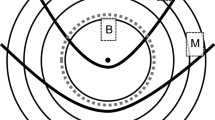Abstract
A critical analysis of recent interventionist responses to the causal exclusion problem is presented. It is argued that the response can indeed offer a solution to the problem, but one that is based on renouncing the multiple realizability thesis. The account amounts to the rejection of nonreductive physicalism and would thus be unacceptable to many. It is further shown that if the multiple realizability thesis is brought back in and conjoined with the interventionist notion of causation, inter-level causation is ruled out altogether.

Similar content being viewed by others
Notes
Note that contrary to what Shapiro (2010, 2012) proposes, it does not help to postulate an additional variable P 0 that is supposed to function as a prior common cause of both M and P, for let V = {P 0, M, P, M*, P*}, where the previous constraints apply. If you now want to test whether M is a cause of P*, with respect to V, you must again hold fixed all the other variables in V. So you hold fixed not only P but also its cause P 0, which means that there is no reason to think that P* would change. Hence, just like above, M is not a cause of P*. The requirement that one must hold fixed the common causes is simply contained in the requirement that one has to hold fixed all the other variables except the hypothetical cause and effect variables.
More precisely: it is possible to hold M present while its realizer is being manipulated. If M is absent, its possible realizers must also be absent and their states cannot be changed without simultaneously changing the state of M (for the presence of any realizer would necessitate the presence of M).
To be clear, these results are based on the semantics of counterfactuals introduced by List and Menzies (2009). It is assumed that there is a system of nested spheres of possible worlds centered on w and that the smallest sphere around w contains worlds where different physical realizers of the mental properties are present. Each of these worlds counts as a relevant possible alternative from the perspective of w. Among these worlds are both (M & ~P)-worlds and (M* & ~P*)-worlds.
Note that none of this needs to contradict the results of List and Menzies’ (2009). They use only a single effect property (B) that is deemed to be on a higher or lower-level depending on the level of the cause property. So List and Menzies (2009) do not actually address the issue of inter-level causation at all, even though their use of the notions of “upwards exclusion” and “downwards exclusion” might suggest otherwise.
References
Baumgartner M (2009) Interventionist causal exclusion and non-reductive physicalism. Int Stud Philos Sci 23:161–178
Campbell J (2010) Control variables and mental causation. Proc Aristot Soc 110:15–30
Kim J (1993) The nonreductivist’s troubles with mental causation. In: Heil J, Mele A (eds) Mental causation. Oxford University Press, Oxford
Kim J (1998) Mind in a physical world: an essay on the mind-body problem and mental causation. MIT Press, Cambridge
Kim J (2005) Physicalism, or something near enough. Princeton University Press, Princeton
List C, Menzies P (2009) Nonreductive physicalism and the limits of the exclusion principle. J Philos 106:475–502
Menzies P (2008) The exclusion problem, the determination relation, and contrastive causation. In: Hohwy J, Kallestrup J (eds) Being reduced. Oxford University Press, Oxford
Menzies P, List C (2010) The causal autonomy of the special sciences. In: Macdonald G, Macdonald C (eds) Emergence in mind. Oxford University Press, Oxford
Raatikainen P (2010) Causation, exclusion, and the special sciences. Erkenntnis 73:349–363
Shapiro LA (2000) Multiple realizations. J Philos 97:635–654
Shapiro LA (2004) The mind incarnate. MIT Press, Cambridge
Shapiro LA (2008) How to test for multiple realization. Philos Sci 75:514–525
Shapiro LA (2010) Lessons from causal exclusion. Philos Phenomenol Res 81:594–604
Shapiro LA (2012) Mental manipulations and the problem of causal exclusion. Australas J Philos 90:507–524
Shoemaker S (1980) Causality and properties. In: van Inwagen P (ed) Time and cause. D. Reidel Publishing, Dordrecht
Shoemaker S (1998) Causal and metaphysical necessity. Pac Philos Q 79:59–77
Shoemaker S (2007) Physical realization. The Clarendon Press, Oxford
Stoljar D (2008) Distinctions in distinction. In: Hohwy J, Kallestrup J (eds) Being reduced. Oxford University Press, Oxford
Woodward JF (2003) Making things happen: a theory of causal explanation. Oxford University Press, New York
Acknowledgments
I am grateful to an anonymous referee of Topoi for her critical comments on an earlier version of this article. This study has been financially supported by the Finnish Cultural Foundation and the Waldemar von Frenckell Foundation.
Author information
Authors and Affiliations
Corresponding author
Rights and permissions
About this article
Cite this article
Pernu, T.K. Causal Exclusion and Multiple Realizations. Topoi 33, 525–530 (2014). https://doi.org/10.1007/s11245-013-9159-x
Published:
Issue Date:
DOI: https://doi.org/10.1007/s11245-013-9159-x




